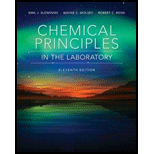
(a)
Interpretation : The moles of
Concept Introduction : The mole concept is mainly used to determine the stoichiometry of any
(a)
Answer to Problem 1ASA
In the given reaction,
Explanation of Solution
Given:
Mass of
Formula mass of
Concentration of
Final volume of solution =
Substitute the values in the given formula to calculate no. of moles of
(b)
Interpretation : The molarity of
Concept Introduction : The mole concept is mainly used to determine the stoichiometry of any chemical reaction. It is used to calculate the mass of the reactant used or the amount of product formed during the chemical reaction. The relation between mass and moles of any chemical substance can be written as:
(b)
Answer to Problem 1ASA
In the given reaction the molarity of
Explanation of Solution
Given:
Mass of
Formula mass of
Concentration of
Final volume of solution =
Calculated the moles of
Expression for molarity is as follows:
Hence molarity of
(c)
Interpretation : The mole of
Concept Introduction : The mole concept is mainly used to determine the stoichiometry of any chemical reaction. It is used to calculate the mass of the reactant used or the amount of product formed during the chemical reaction. The relation between mass and moles of any chemical substance can be written as:
(c)
Answer to Problem 1ASA
In the given reaction mole of
Explanation of Solution
Given:
Molarity of
Volume =
Relation between molarity and volume is as follows:
Substitute values in the above expression to calculate no. of moles as follows:
Want to see more full solutions like this?
Chapter 28 Solutions
Chemical Principles in the Laboratory
- Vitamin C has the formula C6H8O6. Besides being an acid, it is a reducing agent. One method for determining the amount of vitamin C in a sample is to titrate it with a solution of bromine, Br2, an oxidizing agent. C6H8O6(aq) + Br2(aq) 2 HBr(aq) + C6H6O6(aq) A 1.00-g "chewable" vitamin C tablet requires 27.85 ml of 0.102 M Br2 for titration to the equivalence point. What is the mass of vitamin C in the tablet?arrow_forwardTwo students titrate different samples of the same solution of HCl using 0.100 M NaOH solution and phenolphthalein indicator (Figure 4.12). The first student pipets 20.0 mL of the HCl solution into a flask, adds 20 mL of distilled water and a few drops of phenolphthalein solution, and titrates until a lasting pink color appears. The second student pipets 20.0 mL of the HCl solution into a flask, adds 60 mL of distilled water and a few drops of phenolphthalein solution, and titrates to the first lasting pink color. Each student correctly calculates the molarity of an HCl solution. What will the second students result be? (a) four times less than the first students result (b) four times greater than the first students result (c) two times less than the first students result (d) two times greater than the first students result (e) the same as the first students resultarrow_forwardCalcium carbonate, CaCO3, can be obtained in a very pure state. Standard solutions of calcium ion are usually prepared by dissolving calcium carbonate in acid. What mass of CaCO3 should be taken to prepare 500. mL of 0.0200 M calcium ion solution?arrow_forward
- What mass of solid aluminum hydroxide can be produced when 50.0 mL of 0.200 M Al(NO3)3 is added to 200.0 mL of 0.100 M KOH?arrow_forwardA 0.500-L sample of H2SO4 solution was analyzed by taking a 100.0-mL aliquot and adding 50.0 mL of 0.213 M NaOH. After the reaction occurred, an excess of OH ions remained in the solution. The excess base required 13.21 mL of 0.103 M HCl for neutralization. Calculate the molarity of the original sample of H2SO4. Sulfuric acid has two acidic hydrogens.arrow_forwardSuppose you dilute 25.0 mL of a 0.110 M solution of Na2CO3 to exactly 100.0 mL. You then take exactly 10.0 mL of this diluted solution and add it to a 250-mL volumetric flask. After Ailing the volumetric flask to the mark with distilled water (indicating the volume of the new solution is 250. mL), what is the concentration of the diluted Na2CO3 solution?arrow_forward
- What mass of solid AgBr is produced when 100.0 mL of 0.150 M AgNO3 is added to 20.0 mL of 1.00 M NaBr?arrow_forwardTry and answer the following questions without using a calculator. a A solution is made by mixing 1.0 L of 0.5 M NaCl and 0.5 L of 1.0 M CaCl2. Which ion is at the highest concentration in the solution? b Another solution is made by mixing 0.50 L of 1.0 M KBr and 0.50 L of 1.0 M K3PO4. What is the concentration of each ion in the solution?arrow_forward95. Many metal ions form insoluble sulfide compounds when a solution of the metal ion is treated with hydrogen sulfide gas. For example, nickel(II) precipitates nearly quantitatively as NiS when H2S gas is bubbled through a nickel ion solution. How many milliliters of gaseous H2S at STP are needed to precipitate all (he nickel ion present in 10. mL of 0.050 M NiCl2 solution?arrow_forward
 Chemistry & Chemical ReactivityChemistryISBN:9781337399074Author:John C. Kotz, Paul M. Treichel, John Townsend, David TreichelPublisher:Cengage Learning
Chemistry & Chemical ReactivityChemistryISBN:9781337399074Author:John C. Kotz, Paul M. Treichel, John Townsend, David TreichelPublisher:Cengage Learning Chemistry & Chemical ReactivityChemistryISBN:9781133949640Author:John C. Kotz, Paul M. Treichel, John Townsend, David TreichelPublisher:Cengage Learning
Chemistry & Chemical ReactivityChemistryISBN:9781133949640Author:John C. Kotz, Paul M. Treichel, John Townsend, David TreichelPublisher:Cengage Learning Introductory Chemistry: A FoundationChemistryISBN:9781337399425Author:Steven S. Zumdahl, Donald J. DeCostePublisher:Cengage Learning
Introductory Chemistry: A FoundationChemistryISBN:9781337399425Author:Steven S. Zumdahl, Donald J. DeCostePublisher:Cengage Learning ChemistryChemistryISBN:9781305957404Author:Steven S. Zumdahl, Susan A. Zumdahl, Donald J. DeCostePublisher:Cengage Learning
ChemistryChemistryISBN:9781305957404Author:Steven S. Zumdahl, Susan A. Zumdahl, Donald J. DeCostePublisher:Cengage Learning Chemistry: An Atoms First ApproachChemistryISBN:9781305079243Author:Steven S. Zumdahl, Susan A. ZumdahlPublisher:Cengage Learning
Chemistry: An Atoms First ApproachChemistryISBN:9781305079243Author:Steven S. Zumdahl, Susan A. ZumdahlPublisher:Cengage Learning





